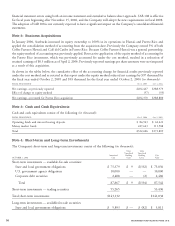Starbucks 2006 Annual Report Download - page 53
Download and view the complete annual report
Please find page 53 of the 2006 Starbucks annual report below. You can navigate through the pages in the report by either clicking on the pages listed below, or by using the keyword search tool below to find specific information within the annual report.Foreign Currency Translation
The Company’s international operations generally use their local currency as their functional currency. Assets and
liabilities are translated at exchange rates in effect at the balance sheet date. Income and expense accounts are translated at
the average monthly exchange rates during the year. Resulting translation adjustments are recorded as a separate
component of “Accumulated other comprehensive income.”
Income Taxes
The Company computes income taxes using the asset and liability method, under which deferred income taxes are
provided for the temporary differences between the financial reporting basis and the tax basis of the Company’s assets and
liabilities. The Company establishes, and periodically reviews and re-evaluates, an estimated contingent tax liability to
provide for the possibility of unfavorable outcomes in tax matters in accordance with the requirements of SFAS No. 5,
“Accounting for Contingencies” (“SFAS 5”).
Earnings per Share
The computation of basic earnings per share is based on the weighted average number of shares and common stock units
that were outstanding during the period. The computation of diluted earnings per share includes the dilutive effect of
common stock equivalents consisting of certain shares subject to stock options.
Common Stock Share Repurchases
The Company is allowed to repurchase shares of its common stock under a program authorized by its Board of Directors
including pursuant to a contract, instruction or written plan meeting the requirements of Rule 10b5-1(c)(1) of the
Securities Exchange Act of 1934. Share repurchases are not displayed separately as treasury stock on the consolidated
balance sheets or consolidated statements of shareholders’ equity in accordance with the Washington Business Corpo-
ration Act. Instead, the par value of repurchased shares is deducted from “Common stock” and the remaining excess
repurchase price over par value is deducted from “Additional paid-in capital” and from “Retained earnings,” once
additional paid-in capital is depleted. See Note 13 for additional information.
Recent Accounting Pronouncements
In July 2006, the FASB issued Interpretation No. 48 (“FIN 48”), “Accounting for Uncertainty in Income Taxes, an
interpretation of FASB Statement No. 109,” which seeks to reduce the diversity in practice associated with the accounting
and reporting for uncertainty in income tax positions. This Interpretation prescribes a comprehensive model for the
financial statement recognition, measurement, presentation and disclosure of uncertain tax positions taken or expected to
be taken in income tax returns. FIN 48 is effective for fiscal years beginning after December 15, 2006, and the Company
will adopt the new requirements in its fiscal first quarter of 2008. The cumulative effects, if any, of adopting FIN 48 will
be recorded as an adjustment to retained earnings as of the beginning of the period of adoption. The Company has not yet
determined the impact, if any, of adopting FIN 48 on its consolidated financial statements.
In September 2006, the FASB issued SFAS 157, “Fair Value Measurements” (“SFAS 157”), which defines fair value,
establishes a framework for measuring fair value in GAAP, and expands disclosures about fair value measurements. SFAS
157 is effective for financial statements issued for fiscal years beginning after November 15, 2007, and interim periods
within those fiscal years. Early adoption is permitted. Starbucks must adopt these new requirements no later than its first
fiscal quarter of 2009. Starbucks has not yet determined the effect on the Company’s consolidated financial statements, if
any, upon adoption of SFAS 157, or if it will adopt the requirements prior to the first fiscal quarter of 2009.
In September 2006, the SEC staff issued Staff Accounting Bulletin No. 108, “Considering the Effects of Prior Year
Misstatements when Quantifying Misstatements in Current Year Financial Statements” (“SAB 108”). The intent of
SAB 108 is to reduce diversity in practice for the method companies use to quantify financial statement misstatements,
including the effect of prior year uncorrected errors. SAB 108 establishes an approach that requires quantification of
STARBUCKS CORPORATION, FORM 10-K 49
























